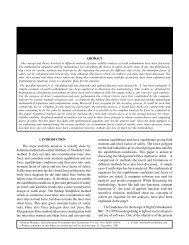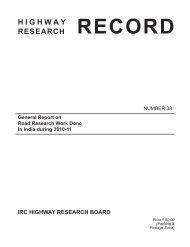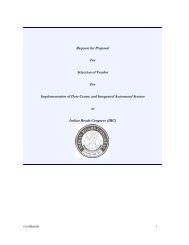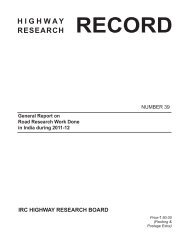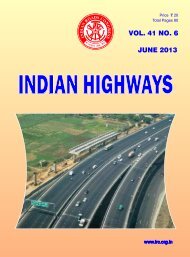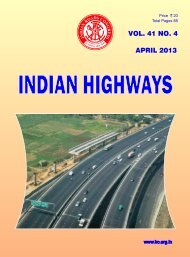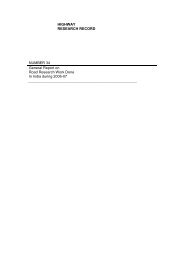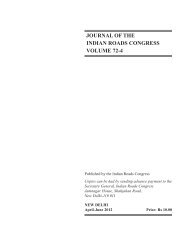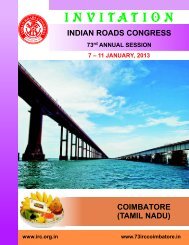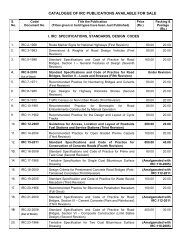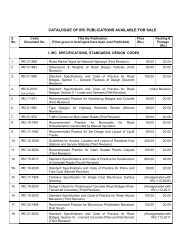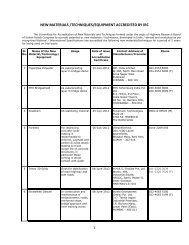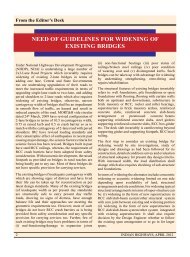A Review of Highway Agencies in the South Asia Region
A Review of Highway Agencies in the South Asia Region
A Review of Highway Agencies in the South Asia Region
Create successful ePaper yourself
Turn your PDF publications into a flip-book with our unique Google optimized e-Paper software.
A <strong>Review</strong> <strong>of</strong> <strong>Highway</strong> <strong>Agencies</strong> <strong>in</strong> <strong>the</strong> <strong>South</strong> <strong>Asia</strong> <strong>Region</strong><br />
Table A3: Computation <strong>of</strong> SPI<br />
Step 1: The analysis should <strong>in</strong>clude all such projects which were <strong>in</strong> progress at <strong>the</strong> beg<strong>in</strong>n<strong>in</strong>g<br />
<strong>of</strong> <strong>the</strong> previous FY and were completed at <strong>the</strong> end <strong>of</strong> <strong>the</strong> previous FY but exclude such<br />
projects whose orig<strong>in</strong>al contract cost was less than `500 million.<br />
Step 2: All such projects (from Step 1) should be divided <strong>in</strong>to two categories:<br />
(a) Projects whose orig<strong>in</strong>al contract cost is more than `500 million and less than<br />
`1,000 million<br />
b) Project whose orig<strong>in</strong>al contract cost is more than `1,000 million<br />
Step 3: These two categories would be fur<strong>the</strong>r divided <strong>in</strong>to three:<br />
(a) Projects which were completed with a time overrun <strong>of</strong> 30 percent or less<br />
(b) Project which were completed with a time overrun <strong>of</strong> more than 30 percent but less than<br />
50 percent<br />
(c) Projects which were completed with a time overrun <strong>of</strong> more than 50 percent<br />
An illustrated example is presented <strong>in</strong> Table A3 to calculate <strong>the</strong> SPI.<br />
Category <strong>of</strong> Projects Projects Weighted Projects Weighted Score<br />
(>`500 m`1000 m)<br />
(%) (%)<br />
Projects completed with x 1 1.0 y 1 1.0<br />
time overrun <strong>of</strong> 30% or less<br />
Projects completed with x 2 0.6 y 2 0.5<br />
time overrun <strong>of</strong> more than<br />
30% but less than 50%<br />
Projects with cost x 3 0.1 y 3 0.1<br />
overrun more than 50%<br />
Total (100%) (100%)<br />
( x x 1.0 + y x 1.0) + ( x x 0.6 + y x 0.5) + ( x x 0.1 + y x 0.1)<br />
1 1 2 2 3 3<br />
SPI =<br />
2<br />
The SPI value ranges from a maximum <strong>of</strong> 100 to a m<strong>in</strong>imum <strong>of</strong> 10.<br />
Indicator 20: Network Congestion Indices<br />
The highway agency is expected to carry out regular traffic volume counts on <strong>the</strong> CRN twice<br />
a year and seven days at a time. Besides such counts, <strong>the</strong> agency may also establish a few<br />
permanent traffic count stations for round-<strong>the</strong>-clock automatic traffic counts. The Network<br />
Congestion Index <strong>in</strong>dicator is <strong>in</strong>tended to capture <strong>the</strong> level <strong>of</strong> congestion <strong>in</strong> terms <strong>of</strong> volume<br />
divided by capacity (v/c) ratio.<br />
The level <strong>of</strong> service (LOS) concept from <strong>the</strong> <strong>Highway</strong> Capacity Manual (HCM) <strong>of</strong> <strong>the</strong> USA<br />
is adopted/adapted <strong>in</strong> several countries <strong>in</strong>clud<strong>in</strong>g <strong>South</strong> <strong>Asia</strong>. LOS reflects operat<strong>in</strong>g<br />
conditions <strong>in</strong> terms <strong>of</strong> traffic performance relat<strong>in</strong>g to speed, travel time, freedom to<br />
manoeuver, traffic <strong>in</strong>terruptions, comfort and convenience. Six levels <strong>of</strong> service are usually<br />
followed. Traffic performance for each LOS is:<br />
LOS A = Free Flow<br />
LOS B = Reasonably Free Flow<br />
82



